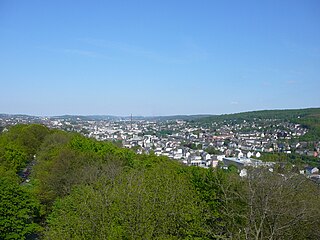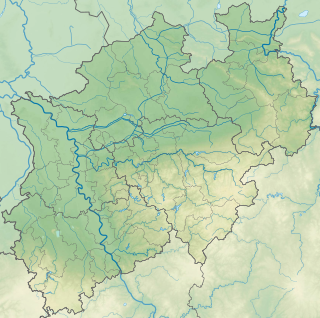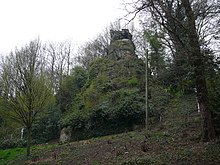Barmer limestone sink
| Barmer limestone sink | |||
|---|---|---|---|
| View into the Barmer limestone basin | |||
| Systematics according to | Handbook of the natural spatial structure of Germany | ||
| Greater region 1st order | Low mountain range threshold | ||
| Greater region 2nd order | Rhenish Slate Mountains | ||
| Main unit group | 33 → Süderbergland |
||
| About main unit | 337 → Bergisch-Sauerland lowlands |
||
| 4th order region (main unit) |
337 1 → Bergisch-Märkisches hill country |
||
| 5th order region | 337 1 .3 → Wuppertal Valley |
||
| Natural space |
337 1 .33 → Barmer limestone basin |
||
| Geographical location | |||
| Coordinates | 51 ° 16 '14 " N , 7 ° 11' 50" E | ||
|
|||
| Local area | Barmen | ||
| local community | Wuppertal | ||
| state | North Rhine-Westphalia | ||
| Country | Germany | ||
The Barmer Kalksenke is a natural spatial unit with the order number 337 1 .33 in the urban area of the Bergisch metropolis of Wuppertal (district Barmen ) within the Wuppertal valley . The depression consists of heavily folded mass limestone from the Central Devon, which has been eroded and karstified by heavy rainfall .
It encompasses the valley floor of the Wupper , which is at an average height of 160 m and rises in steps to the north up to 200 m on limestone plateaus. These limestone plateaus are steep-walled and are divided into individual plateaus by karstified side valleys. In the ascent to the limestone plateau, rock formations like the Hohenstein can be found here and there.
Further north and south, steep slopes rise to high ridges and plateaus (up to 340 m), which consist of greywacke , sandstone and slate . In the east the Barmer Kalksenke merges into the Linderhauser Senke , in the west the Hardtschieferrücke separates it from the Elberfeld Kalksenke .
Flowing on the southern border of the mass limestone area, the Wupper itself hardly contains any limestone. The resulting " soft water " was very suitable for bleaching yarns, which grew into an important industry in Barmen as early as the 16th century.
The depression has an average width of 200 m and is completely taken up by the dense settlement and commercial areas of the industrial city of Wuppertal. The Federal Highway 7 and Elberfeld-Dortmund railway follow the river in the valley.


